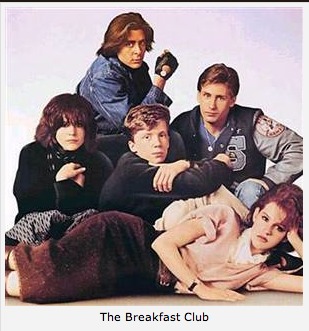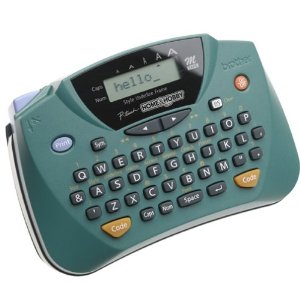How To Avoid Paper Management Mistakes–Part 3: Libel of Labels
“Don’t rely too much on labels, for too often they are fables.”
~Charles H. Spurgeon
“Once you label me, you negate me.”
~Sren Kierkegaard
“Labels are devices for saving talkative persons the trouble of thinking.”
~John Morley, Viscount of Blackburn
Outside of the organizing field, the view of labels is twofold. We’re warned against labeling, for fear of reducing that which is labeled to something without nuance. You remember the final soliloquy of The Breakfast Club, don’t you?

Conversely, the advertising industry (remember “Libby’s Libby’s Libby’s on the Label, Label, Label“?), would have us believe that without labeling, we’d be lost in a sea of confusion.
As a fan of John Hughes, it pains me to say this, but when it comes to paper management, I must side with Don Draper. Labeling is essential.
Over the last two weeks, we reviewed some of the major mistakes of paper management in Paper Doll Explains How To Avoid Paper Management Mistakes — Part 1 and How To Avoid Paper Management Mistakes–Part 2: Fat Vs. Skinny Jeans:
Mistake #1: You Have No Physical System At All
Mistake #2: You Have No Behavioral System In Place
Mistake #3: You Toss Just About Every Piece of Paper in the Trash
Mistake #4: You Save Everything Until the Paper Crowds You Out
Today, we look at the final set of paper management mistakes that can keep you from having a productive, useful system.
Mistake #5: You Don’t Know How to Label Your Files
In organizing, good function tends to come from good form. In order to organize, you must first purge that which is unnecessary and then take the rest and sort it so that like is grouped with like. We reviewed this with Mistake #1 about having no physical system whatsoever. If you just toss everything together, you have a salad and not a system. Without labels, you don’t know if you have a Side or a Caesar.
Mini-Mistake #5A: You Don’t Label Anything
Nomenclature is important. In your closet, if you mix together all colors and sizes and styles of shirts, it will make it hard to dress in the morning. If, however, all of the long-sleeved dress shirts are grouped together, then all of the short-sleeved dressy casual shirts, and the printed T-shirts, you’ll find it easier to locate what you need. You don’t necessarily need to label parts of your closet with the names of the shirt types.
Individual papers, however, live inside opaque file folders, so the folder can’t show you what’s within. Every manila folder looks alike, with the contents obscured just the same as if you stored each article of clothing in an identical garment bag. Thus, labeling tells you what you have, specifically.
Mini-Mistake #5B: You Have a Labeling System That Is Too Broad
If your categories are too broad, and a file folder is labeled as “financial papers”, you will soon find the folder overflowing and it will be impossible to find the exact paper, for the exact date, that you need. Narrowing the categories down only slightly will yield, not surprisingly, only a slight improvement.
“Bank Statements” or “Brokerage Statements” might be fine categories if you have only one of each type of account and never augment or change. If, however, you have a personal checking account with Wells-Fargo, a business checking account with Bank of America and a savings account with ING, you might save a few seconds when filing a particular bank statement in a catch-all banking file, but you’ll waste precious time if trying to retrieve it.
Mini-Mistake #5C: You Have a Labeling System That Is Too Narrow
Another common mistake I see is that, having neglected to visualize any kind of hierarchy in advance, people will create a file folder and label it such that it reflects the one piece of paper it holds. Thus, I’ll find file folders labeled:
IRA Statement 3rd Quarter 2008
Car Insurance Bill 6/2009
Karen’s Report Card — Spring 3rd Grade
There’s so little in each folder, and each folder is labeled so narrowly as to allow such a tiny subset of all of the papers owned, that the user is wasting folders, space, time, effort and efficiency.
A folder can actually neatly contain a year or more of IRA statements. (If end-of-year statements duplicate the information on the monthly or quarterly statements, shred the interim papers.) Even if one has a penchant for saving old (and not necessarily needed) insurance policy documentation, a folder can probably hold one car’s (or one household’s cars’) policies for multiple years. And, in most cases, all of Karen’s report cards from Kindergarten through graduation can likely fit tidily in one folder.
Sidebar on Specificity
I’m an unapologetic fan of specificity. Unless a client has a particular reason to contravene my usual approach, I’m more likely to make a file with the name of each individual account. For example, I’ll use the actual bank name, account type and maybe even the last four digits of the account number if the client has complex financial holdings. Similarly, I’m far more likely to create file folders that state the company name: Comcast, Verizon, Bank of America, Terminex. However, if you tend to move frequently enough that your label names might change every few years, it’s certainly fine to create general categorical labels: Cable, Phone, Mortgage, Exterminator.
Not every professional organizer agrees with this technique. Many of my colleagues find my method a bit fussy; they’re fans of the Freedom Filer approach, which files away monthly non-deductible bills (like utilities, for example) in a dated folder for the appropriate month, with the expectation that most pieces of paper filed away will not need to be accessed again. This approach also allows for quick and easy destruction for collected months that have aged out of the records retention schedule’s “current” category.
When it comes to filing, there are few absolutes. Experts differ, but I think you’ll find that we’d all agree that you should pick a system that works for you, and stick with it. Commitment to a system, rather than the system itself, is usually the final arbiter of success.
Sidebar on Fat vs. Fit Files
When we talked about Mistake #4 last week, we noted, in general, the importance of purging as necessary. Well, don’t just slim down your system — keep individual files lean, too, and label accordingly.
So, instead of a file for all business expenses, you may choose to have one to correspond with each business expense category on the Schedule C (if you’re a sole proprietor or LLC). If your personal medical history file is so thick that it’s causing the hanging folder to bow and bend, break the file down chronologically (Medical History 1996-1999, 2000-2004, 2005-2009, 2010+) so that no file is thicker than about 1/2″-3/4″, and aim for your hanging folders to have no more than three interior files, each.
Keeping your files neither too fat and all-encompassing to be handy nor so specific as to be inefficiently and useless, will help you find the papers you need whenever you need them.
Sidebar on Uniformity
No matter how much specificity you choose when labeling files, seek uniformity in your naming system. If one folder says ’96 Hyundai Repairs, while another says Maintenance For Mary’s Car, even if the two are placed together in your filing system, the lack of uniformity will make your brain stop, for just the slightest moment, when you’re searching for what you need. Opt for parallel structure in labeling.
Mini-Mistake #5D: You Have Messy, Unreadable Labels
Paper Doll has two types of handwriting: the relatively neat, painstaking cursive I use for Thank You notes, condolence letters, and the rare check, and the scribble I use for grocery lists and phone numbers transcribed from voice mail. A lifetime of using computers has eroded whatever handwriting skills Ms. Minklein, my beloved second and third grade teacher, imparted to me.
If you have exquisite penmanship, I encourage you to save time and resources and to label your files on your own, with a sharp Sharpie or other pen. However, if your handwriting resembles nothing so much as a two-year-old’s attempts at map-making, I encourage you to invest a small amount of money in a label maker. Brother no longer makes my adored PT-65 but both Brother and Dymo, the leaders in labeling, have excellent hand-held label maker lines.
In the coming months, this space will present a comparative analysis of brands and models and the keys to selecting a label maker, but for most household and small office purposes, any affordable label maker with a QWERTY keyboard should suffice.
Sidebar on Authority:
Although I have yet to find any academic research on the subject, it’s my professional belief and experience that users are more likely to file away their papers when their paper management system bears the “official” imprint of typewritten labels. I suppose those who are iconoclasts might rebel against “the Man”, but I’ve found that neat, uniform, typed labels tend to incline people towards loyally maintaining their filing systems more so than handwritten, scribbled labels.
Mini-Mistake #5E: You Have a Labeling PLACEMENT System That is Too Complicated
Labeling isn’t just about what it says on the label. Some systems rise or fall on the complexity of how and where they are labeled. To that end, I suggest two rules:
Skip 1/5 cut label tabs. You’ve seen those manila file folders with tiny one-inch tabs positioned at left, left of center, center, right of center and right. These tabs are simply too small to create meaningful labels unless you choose the absolute smallest font-size on your label maker or hand-print in teeny, tiny letters, thereby making the labels fit, but less easy to read from a distance. Just say no. Stick with 1/3 cut label tabs.
Don’t fuss over placement. I know people who have strict rules regarding placement of file folders and hanging folders tabs. For example, they’ll require that all major categories run behind one another, such that all financial accounts should be kept in left-tab files and that sub-categories must be center-tabbed and sub-sub-categories right-tabbed. Conversely, others will require that each successive folder in a system, from to back, should change tab position, from left, to center, to right, and over to left again.
There are two major problems with such approaches.
First, in both cases, if you run out of folders of the “correct” type — if, for example, you want to add a new financial folder but are out of left-tab folders, or if you need to add a new type of insurance policy, but the next folder should be a right-tab and you are out of right-tab folders, you’re stuck. Would you rather rush out and buy a new box of folders ASAP, or risk putting off completing your filing system until the next time you might feel inspired?
The second problem only involves the left-center-right (lather, rinse, repeat) label method. If you had a new sub-category to add, but the folders behind that category have already “restarted” the left-center-right pattern, your new folder will be the odd man out. A rigid system just sets you up for failure because it violates Mini-Mistake #4e, the one about leaving no room for the future.
For those of you who just don’t worry that much about file placement, I applaud you.
However, for you readers who are perfectionist procrastinators who can’t get started for fear of eventually encountering a “failure”, I have one secret. Did you know that you could flip folders inside-out? It can be a little more obvious that you’ve done so with colored folders than standard manila, but if you flip a left-tab folder inside-out, you now have a right-tab folder, and vice versa. It’s no miracle, but it helps keep the paper management process moving forward when things get bogged down.
Again, the simpler you can make your system, the better. As Albert Einstein said:
“Everything should be made as simple as possible, but no simpler.”

Most people think Einstein was probably thinking about quantum mechanics or the mysteries of the universe when he said that. But before he was a world-famous physicist, Einstein worked in a patent office. And throughout his career, he was surrounded by paper clutter. Albert Einstein knew about paper management mistakes. Just imagine what magnificent things he might have discovered if he’d just been a little more organized.




Single tab folders & consistent labels help me keep my files in order. I have separate drawers for active & archive files.
Hi, Olive!
I absolutely agree about the importance of consistent labeling, and keeping archived files out of my prime real estate. As for single-tab, I can see the appeal, but if you’re I’m using a label maker, I find that the small label on the wide expanse of a full tab can get a little lost, making the eye take longer to “find” the word(s). (Of course, it’s also a little harder to eyeball the center of one long folder-width tab. Or maybe my eyes have just gotten old!) 😉 This does make me wonder whether it might be worth exploring the two-tab folders (which are generally so hard to find).
Thanks for reading!